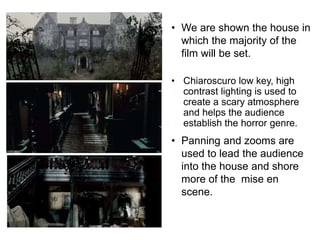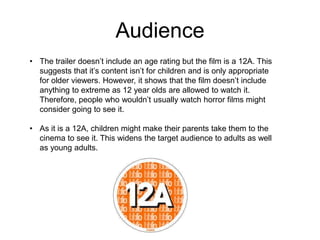The Woman in Black Film Trailer Analysis
- 1. The Woman in Black- Trailer Analysis
- 2. Introduction to Film Trailers • The purpose of trailers are to promote and advertise new films. They inform the audience about release dates for films and show what the film is going to be about, without giving too much away. • They are usually shown before films being screened in cinema; the film being advertised usually has the same target audience as the film being shown because the audience are more likely to be interested in that type of film. They are also shown on television during advert breaks and before YouTube videos. • Trailers are used to create excitement about a film’s release.
- 3. The title of the film was put at the end of the film so that, if the viewer was interested in going to see the film after watching the trailer, it would stick in their mind.
- 4. • The window is being shown from the inside which suggests someone is trapped in the ‘haunted house’ • The weather is dismal which is a pathetic fallacy, reflecting the mood and genre of the film • The shadows on the window suggest the film is going to be dark and scary • The font is in serif suggesting the film is for an older audience and it also looks like old fashioned writing which shows that the film is going to be set in the past • The titles are in black and white which hints that the film isn’t going to be happy/funny because of the lack of colour • Daniel Radcliffe’s name is included because it is recognisable and people might want to see the film if they are a fan of his work.
- 5. Characters • Daniel Radcliffe plays the main character, Arthur Kipps. He is a well known for playing Harry Potter so people will be more likely to watch it because they liked the Harry Potter series. • I think this character starts as a Proppian ‘damsel in distress’ then develops into a Proppian hero because he is going to try and restore the equilibrium of peace in the house and village.
- 6. • We are introduced to the main character when there is a medium long shot of a horse and cart on the way to the isolated house. He is looking back which shows he is unsure whether to turn back or not. • The cross in this shot could represent death and resurrection as there is a ghost that has come back from the dead to haunt the house. Crosses can also mean ‘do not enter’ which connotes he is going towards danger.
- 7. • Throughout the trailer, Arthur Kipps is shown alone and vulnerable. This is done on purpose so that the audience sympathise with him and want him to get out of the house alive.
- 8. • The villain of the film is the Woman in Black. She is the mysterious character that makes the children kill themselves, which disrupts the equilibrium. • She is introduced when we see her standing in the window of the house. We can’t see her face properly which creates mystery and the fact that we know so little about her makes the audience want to find out more.
- 9. Location The non-diegetic voice over tells us the main locations of the film- “There are those who believe the whole town is cursed, but the house in the marsh is by far the worst.”
- 10. The first thing we see in the trailer is an abandoned playroom in an old fashioned house. Abandoned places, such as haunted houses, are often used in horror films to make the victim look alone and more vulnerable. It connotes that the film is going to be set in what was once a family home and hints that the storyline will be about what happened to the children.
- 11. • We are shown the house in which the majority of the film will be set. • Chiaroscuro low key, high contrast lighting is used to create a scary atmosphere and helps the audience establish the horror genre. • Panning and zooms are used to lead the audience into the house and shore more of the mise en scene.
- 12. Binary Oppositions Good vs Bad Innocence vs Corruption Life vs Death
- 13. Barthes’ enigma theory says that the purpose of the trailer is to create mystery. This applies to the Woman in Black as the trailer makes the audience ask questions. Who is the Woman in Black? Why does she haunt the house? What is Arthur Kipps doing at the house? Will he survive?
- 14. Editing • The pace of editing starts off slow so the audience get chance to understand the basic storyline. • The editing pace gets faster near the end to build up tension and to make the audience jump. • There is a series of short clips that appear one after the other, very quickly. This is also done so it doesn’t give away too much and the audience will be left eager to watch the full film. It also makes them question what they’ve seen.
- 15. There is an extreme long shot of the land outside the abandoned house showing how isolated it is. This suggests to the audience that if something happens, no one will be there to save him. The sense of isolation creates an uneasy atmosphere.
- 16. Many people find creepy dolls and clowns scary and they are often used in horror films. After the play room establishing shot, there are close ups of them as they start to move suggesting paranormal activity.
- 17. Sound • Throughout the establishing shot there is a wind noise which emphasises the feeling of isolation. • A toy monkey then starts playing an instrument which suggests paranormal activity in the house. The rest of the toys start playing and the noise starts to sound like a children’s song from a music box. The tempo of the tune is slow and steady and the shots change as each note is played. This creates a sense of unease. • The tune is repetitive which could represent how the woman in black is always there. • A non-diegetic voice over start. It is a little girl giving the audience an idea of what the storyline is going to be.
- 18. The music speeds up and reaches a climax; the instruments clash and get louder which creates a sense of uneasiness and connotes danger in the house. Just as the music reaches a crescendo, a high angle shot of Arthur Kipps is shown. This suggests that when he stepped into the house he became vulnerable and out of his comfort zone.
- 19. Audience • The trailer doesn’t include an age rating but the film is a 12A. This suggests that it’s content isn’t for children and is only appropriate for older viewers. However, it shows that the film doesn’t include anything to extreme as 12 year olds are allowed to watch it. Therefore, people who wouldn’t usually watch horror films might consider going to see it. • As it is a 12A, children might make their parents take them to the cinema to see it. This widens the target audience to adults as well as young adults.
- 20. The last thing we see in the trailer is a clip of the main character stood at the window of the house. We already know from the rest of the trailer, that the woman in black had been seen standing at the same window on a number of occasions. When Arthur Kipps is shown standing there at the end, it makes the audience wonder where the ghost is. There is a POV shot to outside and then it cuts back to the close up of the window. This creates suspense because we know something is going to happen but we are not sure where or when. A face then appears next to Daniel Radcliffe’s character, making viewers jump. The clip is short which leaves the audience wanting to know what happens to the vulnerable main character and wanting to go and watch the film.
- 21. Conclusion • In my opinion I think the Woman in Black trailer is extremely effective in attracting an audience. In 2012, The Woman in Black became the fifth biggest independent UK film to be released with over £21 million at the UK box office. I think that the main cause for its success is the trailer; it left people wanting to know what happens next. • Many horror film conventions were shown throughout and the monologue gave a brief outline of the story whilst giving little away. Horror film fans will be drawn in by this and want to know how the film ends. • The way it built up tension left me wanting to watch the full film. In conclusion, I think that this trailer is extremely good and serves its purpose.




















